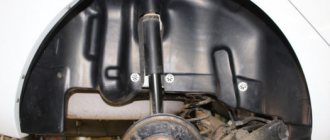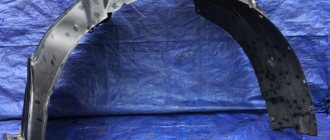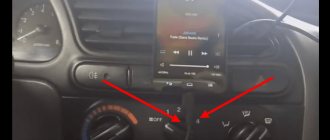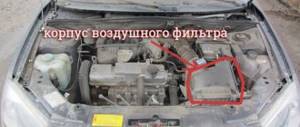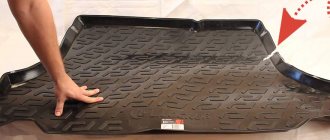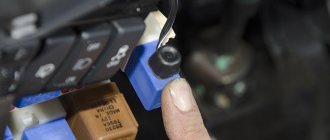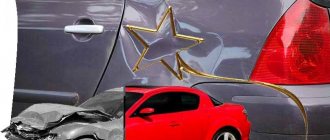Soundproofing options for arches
There are two main options to minimize wheel noise:
- internal - noise-absorbing material is applied to the wheel arches from the side of the car interior;
- external - performed on the outside of the wheel arch at the wheel mount.
For full effect, you can carry out work on both external and internal insulation. In combination with the overall sound insulation of the car, this will give the most positive effect. The work can be done using solid (rubber, foil, rubber) and liquid materials (mastic, liquid rubber).
External sound insulation with foil
This method involves treating the outside of the wheel arch and fender liner with your own hands with a layer of thick aluminum foil.
Stages of work
- The first thing to do is to remove the wheel and locker.
- If there is previously installed worn sound insulation, it must also be removed.
- Thoroughly clean the wheel arch and fastenings from accumulated dirt.
- Degrease the dried surface.
- Cover the surface with a layer of foil at least 8 mm wide.
- A layer of foil is attached on top of the installed bitumen.
- On top of the sound insulation, apply liquid liners to all joints to seal the joints and seams.
- Treat the surface of the locker in the above order.
External method of soundproofing car arches
External sound insulation of wheel arches is the most popular method.
Today, the external method is more popular. It happens as follows:
- We remove the fender liner.
- We clean the anticorrosive agent from it.
- Degrease the surface with white spirit.
- We glue the arch and the outer side of the fender liner with Bimast.
- We glue it with foil splen. We choose the largest thickness – 8 mm.
- Experts recommend lubricating untreated areas with an anti-corrosion coating.
But what to do if the car does not have additional plastic fender liners? In this case, you can use “liquid fender liners” - bitumen-rubber mastics. We apply them with a brush or spray. This is done in the same way as painting - in several layers . Before applying a new layer, you must allow the previous one to dry thoroughly. All suspension elements must be protected from mastic.
Liquid sound insulation
Liquid sound insulation involves treating the wheel arch with sound-insulating liquid materials, which are produced on the basis of rubber raw materials. One of the advantages of this method is the ability to treat the most difficult to reach areas. To process the front and rear arches you will need two hours of time and a dry room, preferably equipped with a car lift. Liquid sound insulation is quite easy to use; anyone can handle it.
- As in the previous version, you need to remove the wheels and thoroughly clean the surface of the arches along with the fastenings from dust and dirt.
- Be sure to also degrease the surface of the arches for better adhesion.
- All suspension elements must be protected from mastic.
- The next step is to apply a soundproofing solution. To do this, you will need a spray bottle or a regular brush of a convenient shape and size. Using the method specified by the manufacturer in the instructions, the solution is applied to the entire surface. Depending on the desired result, the material is applied in one or three layers. Before applying a new layer, the previous one must be dry.
Liquid noise insulation of wheel arches reduces the noise level from wheel friction and vibrations by half. This type of treatment also perfectly protects the car body from corrosion and gravel impacts.
How to make soundproofing of car wheel arches with your own hands
Soundproofing a car with your own hands is much easier than it seems at first glance. It is important to prepare the required materials and tools in advance. And then strictly follow the instructions provided.
If you are not confident in yourself, but want to do it yourself, then it is advisable to consult a specialist. And it’s even better to carry out all manipulations under the supervision of a friend who knows how to do sound insulation.
This article will discuss instructions for installing sound insulation for wheel arches externally.
Required tools and materials
It is recommended to prepare tools and materials for soundproofing wheel arches in advance. Tools can usually be found in any driver's garage.
Do-it-yourself noise insulation of car wheel arches
For installation you will need:
- jack;
- screwdriver;
- knife;
- brushes, can be replaced with a miniature roller;
- latex gloves.
It is recommended to wear rubber gloves before starting work. Material for soundproofing wheel arches is not difficult to find.
You will need the following:
- sheet sound insulator;
- degreaser;
- vibration absorber.
You can buy them at almost any car store. Prices are not high, ranging from 1000-2000 rubles.
Step-by-step instructions for carrying out work
Do-it-yourself noise insulation of wheel arches is best done from the outside.
Try to strictly follow the instructions below:
- it is necessary to remove the wheel;
- if there is a locker, then it is also best to remove it;
- now you need to remove the factory sound insulation from the arches;
- it is also necessary to remove the anti-corrosion coating;
- degrease the surface;
- Next you need to apply a vibration absorber;
- If desired, you can glue a sheet of sound insulator.
The process is quite simple. However, if you are doing this for the first time, we recommend that you carry out the installation under the supervision of a more experienced friend. This way you can avoid mistakes, and in the future you won’t have to pay for car repairs.
Liquid-porous sound insulation
It is based on a combined coating technology, which uses sheets of solid and liquid soundproofing material. The most popular among porous vibration-absorbing polymers used for these purposes is Accent. If the vehicle is planned to be used in an area with high levels of moisture in the air, it would be wise to use water-repellent materials such as Izlon or Penofol. They protect body parts from corrosion, rust and other destructive properties of water.
Internal sound insulation of wheel arches
Internal sound insulation is carried out in the car interior at the places where the arches protrude. To do this, the surface must be thoroughly washed and degreased. The optimal material for this type of work is Bimast and Accent.
Bimast is a vibration damper with a high mechanical loss coefficient of 0.4. The bottom layer of the material is equipped with a self-adhesive surface, and it itself is a mastic-bitumen base with a metallized coating. To install Bimast, you need to heat the adhesive layer. This can be done using a regular hair dryer using two methods:
- pre-heat the Bimast until it shines, laying it with the adhesive surface up on a clean surface;
- fix one edge of the sheet to the arch and warm it up with a hairdryer at the installation site.
When using the first option, the heated sheet is applied to the wheel arch and pressed with a roller over the entire area. The second option also involves pressing with a roller after warming up.
Accent noise-absorbing material is most popular due to its absorption characteristics and affordable price.
Stages of work
- Clean the surface from dirt and dust with a soap solution.
- Degrease the surface.
- Glue the entire protruding surface of the wheel arch with Bimast in a convenient way.
- Stick noise-absorbing material Accent on top.
Internal sound insulation of car wheel arches
Internal sound insulation is a list of actions that are carried out from the interior.
Let's look at how to make noise absorption in the wheel arches from the inside of the car. It's a fairly simple diagram that looks like this:
- The surface must be thoroughly cleaned and washed.
- Degrease using white spirit.
- Glue the entire internal area with Bimast using any of the two methods described above in the section on materials.
- Place the Accent sound insulator on top.
This method will help get rid of a significant amount of noise coming from below the car.
Adviсe
We will give some tips when carrying out the work.
- Sound insulation of metal wheel arches and comprehensive insulation of the arch or fender liner gives a more positive effect than insulation of the fender liner alone.
- The temperature of the room in which the work will be carried out should be +20 degrees.
- Sheet materials tend to stretch, which threatens to peel off during use. Make sure that the material lies freely, maybe overlapping a little.
- For high-quality cleaning of the arch covering, you can use the services of a high-pressure washing machine.
- Some car brands have a disposable fender liner mounting system. It is better to clarify information about this and, if necessary, stock up on a set of new fasteners before starting work.
- For a good result, you should not skimp on the quantity and quality of the material and use vibration-isolating and noise-absorbing material in combination.
- When installing sheet material, you need to take pieces of as large a diameter as possible. The more joints, the more noise is passed through.
- When performing external sound insulation, be sure to cover the entire area of the wheel arch, since in case of incomplete installation, condensation will collect under the coating, and then rust and corrosion will form.
- An additional precaution would be to apply an anti-corrosion agent.
Treating wheel arches exclusively will not give 100% effect. In order for the car to become completely quiet and comfortable, you need to completely insulate the car.
Why is sound insulation needed?
The answer is obvious: to reduce noise. But why are the arches insulated? Because this is the “loudest” place in the body. While driving, the tires in contact with the road create noise. The engine is also a source of sound waves. They enter the space above the wheel and are amplified, reflecting repeatedly from its walls. There is a sound like in an empty barrel.
The quality of domestic roads is also not conducive to silence: if you drive mainly on dirt roads, then small stones and dirt rattle, hitting the walls of the arches.
To get rid of the annoying rumble, car enthusiasts resort to a trick: they apply various sound-absorbing materials to the inner surface of the wheel arches. But if the quality of the coating leaves much to be desired, then such “noise insulation” will do more harm than good. It is especially dangerous when arches are insulated with materials that absorb moisture, which are also glued without prior surface preparation. Sooner or later, the paint under such a coating will peel off and corrosion will begin. All this can be avoided if sound insulation is carried out correctly.
This is interesting: Everything about the injectors installed on GAZelles - the device, the main faults and their diagnosis, repair and replacement
